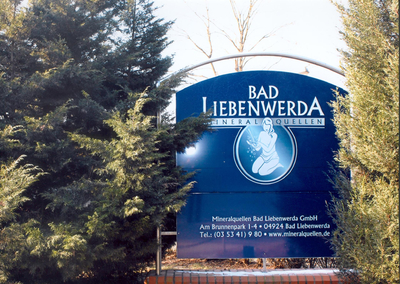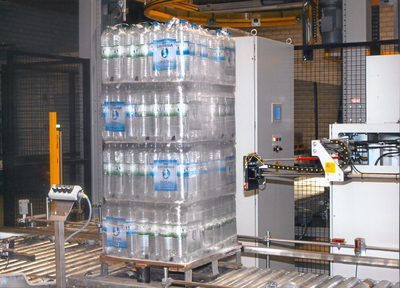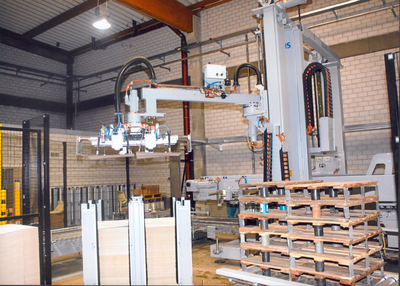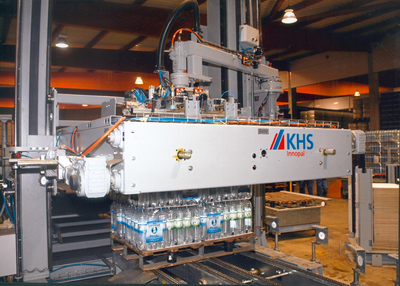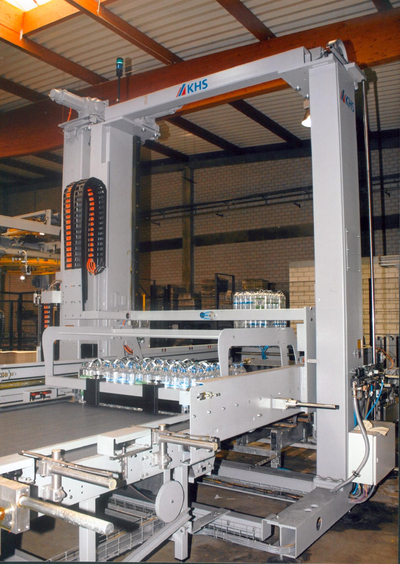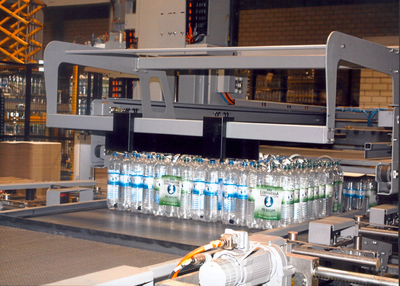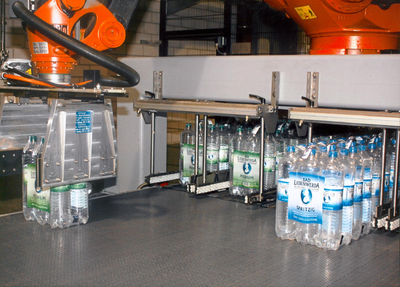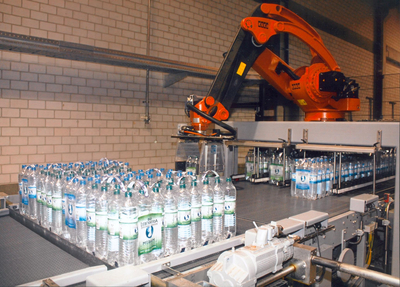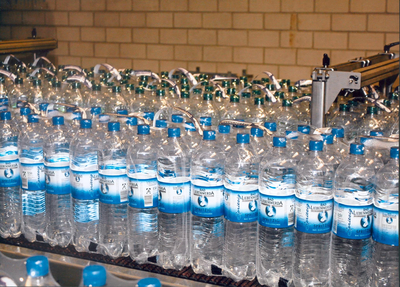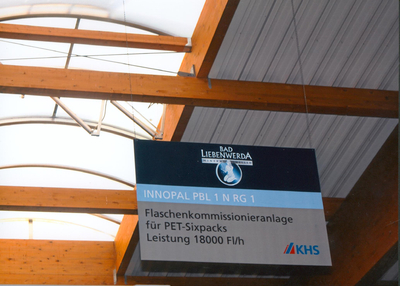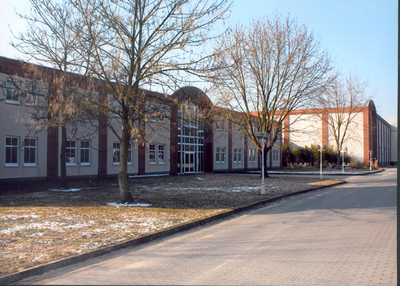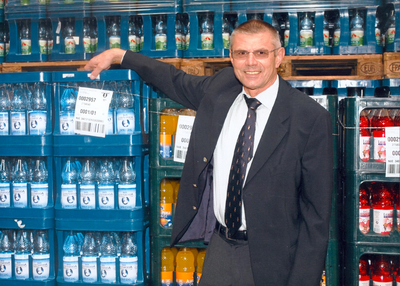
Fairy Tale Growth
Mineralquellen Bad Liebenwerda Continues Success Story
Günter Unkrig* Andreas Waldscheck** Far away from the hectic pace of the big city, surrounded by nature - this is the impression conveyed by health resort Bad Liebenwerda, the headquarters of Mineralquellen Bad Liebenwerda. This mineral water spring is in fact idyllically situated in the heart of the Niederlausitzer Heide. When the border to East Germany was opened in 1989, it was not the location alone, however, that made this mineral water spring attractive to West German investors. What equally counted was the fact that even back then it was an excellently managed production site and commercial business whose name vouched for high quality throughout its previous area of distribution - the Cottbus district. Egon Schindel Holding Founded Prior to his decision to take over VEB Getränke Bad Liebenwerda, Egon Schindel, the owner of RhönSprudel, drew a circle with a pair of dividers. A simple method of determining that big cities such as Berlin, Dresden, Leipzig, Frankfurt/Oder, and Cottbus are all located within a radius of 100 km from Bad Liebenwerda. An outstanding distribution area. Simultaneous with the takeover of Mineralquellen Bad Liebenwerda in December 1990, Egon Schindel founded the Egon Schindel Holding that today is the umbrella for a wide array of successful beverage companies. Along with RhönSprudel and Mineralquellen Bad Liebenwerda, the Egon Schindel Holding is comprised of Bauer-Fruchtsaftbetrieb, Brauerei Alsfeld together with Vogelsberger Mineralbrunnen, Herborner Bären-Bräu, and Adelbodner Mineral- und Heilquellen of Switzerland. Breathtaking Growth Under the management of Horst Kuhl who had been managing VEB Getränke Bad Liebenwerda since 1978 and who subsequently took over the executive position after the opening of the Wall, this mineral water operation has been growing to this very day at almost breakneck speed.* Sales Director for Central Europe, KHS AG, Dortmund Phone: +49 (231) 569-1602 * Sales Manager for Germany, KHS AG, Dortmund Phone: +49 (231) 569-17 34
From 13 to 230 Million Fillings Within 12 Years A new era began in February 1991 with construction activities on recently purchased property. The first line from KHS was installed in August 1991. Today, four glass and PET lines are in operation. By 1991, Mineralquellen Bad Liebenwerda had already reached the 13-million filling mark. The output jumped to 50 million fillings in 1992 and then began a never-endingly ascent. By 1995, the output had climbed to 100 million fillings. The impressive outcome for 2002: 135 million fillings. And the prospects for 2003 couldn't be better. The production increased 30 percent during the first quarter versus the same period the previous year. Added to this are other products filled under contract since the beginning of 2003 that are predicted to reach 80 million fillings this year. Horst Kuhl expects a total of nearly 230 million fillings for the year 2003. Mineralquellen Bad Liebenwerda has advanced to the ranks of Germany's 20 largest mineral water businesses. Seventy Percent Mineral Water Mineral water chalks up approximately seventy percent of all fillings; thirty percent are soft drinks. Carbonated and low-carbonated mineral waters hold equal shares. Interesting: The growth of the Naturell brand of Bad Liebenwerda mineral water launched to the market early 2003. Shortly after introduction to the market, this non-carbonated brand of water captured nearly ten percent of mineral water sales. Leading the Way for Trend Beverages Innovation and a feeling for trends characterize Mineralquellen Bad Liebenwerda not only when it comes to mineral water but also in the soft drink sector. This mineral water business was the first of its kind in Germany to begin producing apple spritzers. With approximately 3 million fillings, the ApplePlus brand of apple spritzer now holds the same share of soft drink sales as traditional orange soda pop. Apple spritzer was followed by other spritzer-type products such as CassisPlus and CherryPlus that have likewise been successfully positioned in the market. Mineralquellen Bad Liebenwerda is also trendy in the “new-age beverage” sector. Jointly with RhönSprudel, Mineralquellen Bad Liebenwerda offers an assortment of products marketed under the Fiesta brand that ranges from ACE-Power through Vita-Power, Sport-Power, and Waldbeer-Power, up to and including Yogurt-Power. Another in product: Hollerblüte and Hollbeere elderberry beverages just recently introduced to the market. All in all, it is primarily the new soft drinks segments that have been steadily consolidating their positions and contributing decisively to growth. In the meantime, they represent forty percent of soft drink sales. Relied Early on Returnable PET Innovation and a feeling for trends. This assertion takes effect once again with regard to the pack policy at Bad Liebenwerda. Mineralquellen Bad Liebenwerda was Germany's first mineral water spring to fill soft drinks in 1.5-liter returnable PET GDB (Genossenschaft Deutscher Brunnen Society of German Mineral Water Producers) bottles. The company was also among the first to introduce 1.0-liter returnable PET bottles for soft drinks and 1.0-liter returnable PET bottles for mineral water. It was not least the very specific decision in favor of returnable PET that brought and brings this mineral water company soaring sales increases. Since introduction of mandatory deposit on no-return packaging, the position of returnable PET has once more improved greatly. Sales of mineral water bottled in returnable PET increased forty percent during the first few months of 2003 while mineral water filled in returnable glass bottles declined twenty percent. The developments in soft drink sales were even more drastic to some extent. Apple juice spritzer for example where returnable glass bottle sales declined 20 percent versus a 91-percent increase in returnable PET sales. Mandatory Deposit Takes Effect Seventy percent of the mineral water sold by Mineralquellen Bad Liebenwerda today is bottled in returnable PET; the share of soft drinks sold in returnable PET totals an impressive sixty percent. Despite of the tremendous success currently being chalked up by this mineral water business with returnable PET, Horst Kuhl expects future growth to be even more significant. The reasons Kuhl gives for this is that eastern German consumers have an extremely receptive attitude towards PET on the one hand and, according to Kuhl, that the mandatory deposit is additionally taking effect on the other. KHS Right from the Start Based on all these facts, the investment in new plant engineering was essentially obvious. Mineralquellen Bad Liebenwerda just recently erected a second production plant and relied once again on its trusted partner and partner "of the first hour" KHS to install a new 30,000 bph non-returnable PET line to fill 1.0-liter returnable PET bottles with mineral water. Most Highly Productive Provider of Returnable PET in Eastern Germany With this new investment, Mineralquellen Bad Liebenwerda aims to achieve a very clearly defined goal of remaining Eastern Germany's most highly productive provider of returnable PET. Gentle Depalletizing The returnable PET processing begins at the triple infeed of Euro pallets loaded with returned crates of empties. The pallets are first singled and then fed to the pallet aligner for centering and then conveyed towards an Innopal RS 3 depalletizer. A clamping head removes the packs very gently from the pallets. After passing through a turning station, the crates arrive at the inspection station where the crates are checked for standard dimensions and for the presence of foreign bottles and foreign crates that could hamper the decrating process. "Bad" crates are conveyed to a manual sorting area while "good" crates travel directly to the decrater. The pallets are run through a pallet inspection station that is also equipped with a pallet pressure check. The pallet pressure checker uses a pressure die to check the respective pallet boards from above and below to determine any damage. “Bad” pallets are stored in a faulty-pallet magazine. “Good” pallets are sent in the direction of the palletizing area via a special buffer magazine. Dry Area Entirely According to Innovative KHS Modular Design Concept An Innopack PP cyclic crater decrates the bottles out of 12-bottle crates. Similar to all components of the dry area, the decrater installed in this case is designed consistently according to the KHS modular dry area concept. A major advantage of this modular dry area concept: Use of a PC-based robot control. Unlike the control concepts of the past, this solution uses only one central intelligence. This intelligence not only coordinates the servo-axles but also controls the peripheral components and provides facilities for VGA-monitor display of machine visualization. With the innovative modular dry area technique, interface problems are a thing of the past. The PC-based robot control exactly pinpoints problem areas leaving no questions unanswered. Horizontal and vertical movements are generated exclusively by toothed belts. This means less servicing effort in addition to decreased noise levels. Servomotors shorten the cycle times and ensure high performance coupled with exact adherence to the so very important positioning accuracy. A great advantage of the modular dry area concept is the high degree of flexibility included the concept plan. Components can be very simply added and relocated for any line designed according to the modular concept. Also integrated in the line along with the Innopack PPZ: A manual infeed table for new bottles where new bottles can be fed to the system as required. The empty crates are turned upside-down by a crate turner to eliminate the last of any remaining foreign objects once and for all and to ensure that nothing stands in the way of transport to the Innoclean KW crate washer. Compact and Reliable: The Superblock Plastic chain mats are used to transport the decrated PET bottles to the Superblock. Plastic mat chains guarantee low friction coefficients in the area of the bottle cup base and gentle pressureless combining. This KHS Superblock handles the task of sorting, decapping, delabeling, and the so very essential foreign substance inspection. The Superblock option offers decisive advantages as opposed to standalone solutions. This not only saves space, shortens conveying distances, needs less conveying control, and requires fewer machine operators but meets maximum demands on state-of-the-art inspection technology as well. Designing conveying starwheels as clamping stars in the KHS Superblock offers the basis for minimizing sources of scuffing which in turn contributes significantly to increasing the number of times each bottle can be recirculated. Once a bottle enters the Superblock, it is no longer released and is subject at all times to controlled guidance. Immediately after entering the KHS Superblock, the contours, heights, and diameters of the PET bottles are checked by a high-resolution CCD camera. Any foreign bottles are channeled out. The bottles undergo a residual liquid inspection on their way to the decapper. After decapping, any bottles containing more than the defined amount of residual liquid are conveyed through a residual liquids draining station back to the machine. A delabeling unit gently removes the labels. A lightly spring-loaded cutting tool follows the contours of the bottles and removes all labels that have not been glued directly to the bottles. The processing program includes channeling out those bottles from which the delabeler was unable to remove labels. Another work step is carried out simultaneously in the delabeling carousel: A liquid is injected by a bus-controlled injection starwheel. This exactly dosed liquid is needed for the USM liquid analysis in the foreign substance inspection unit that follows. The foreign substance inspection unit performs gas and USM liquid analyses within a minimum amount of space. The measuring techniques used are characterized by utmost sensitivity coupled with maximum selectivity. This positive measurement technique reliably detects even the slightest trace of foreign substances. Contaminated bottles are sorted out for disposal on a separate rejection segment. Ultra-modern Cleaning Technology A single-end Innoclean EE bottle washer equipped with ultra-modern cleaning technology is used to wash the "good" bottles. The single-end version of the bottle washer is equipped among other things with the Triple-i drive technology and new KHS energy-saving bottle carriers. The Triple-i-drive technology is characterized by mutual drive independence. Mechanisms are decoupled in the bottle feed and discharge areas as well as during conveying through the bottle washer. An intelligent control provides not only fast data transmission and data interchange among the servo-converters of the drives but enables users to carry out preventative maintenance as well. Clearing the last row of bottles at the push of a button is another of the numerous advantages offered by the Triple-i-drive technology. Manual handling is no longer necessary. The advantage of the so-called energy-saving bottle carrier is reduction of the carrier weight. Selectively made cutouts in the side walls of the bottle carrier make the energy-saving carrier 20 to 35 percent lighter than conventional bottle carriers. Less carrier mass also means reduced heat and caustic carryover, which has a direct effect on the energy and fresh water consumption of the bottle washer. The energy-saving carrier alone uses 10 to 15 percent less heat and 15 to 20 less water. Yet another special feature of the bottle washer: A disinfection bath ahead of the last bottle spray area. Electronically Controlled Probe Filler for Reasons of Appearance An electronically controlled Innofill DRS VF/PET probe filler handles the task of filling the PET bottles. Once the bottle is pressurized, the liquid valve opens and conducts the product over a spreader to the inside walls of the bottle. High valve filling output can be attained during the fast filling phase in the uncritical, cylindrical part of the bottle. Filling is slowed in the narrow bottle neck for exact filling level measurement. A pulse from the probe closes the liquid valve. This is followed by pre- and final depressurization. Due to the probe method of filling, all bottles have the same filling levels, a particularly advantageous item from a standpoint of appearance. Microbiological Filler Front Table Offers Assured Sanitary Conditions The filling concept is enhanced by the microbiological filler front table. The geometrically designed filler front table allows product residue, foam, water, and broken glass to be selectively and quickly conducted to the floor away from the biologically critical area of the filler to ensure maximum microbiological safety in the vicinity of the filler. Prepared for All Eventualities Although Mineralquellen Bad Liebenwerda currently uses the new returnable PET line to fill only mineral water, the line is nevertheless prepared to fill soft drinks. The decision regarding process engineering was made very specifically in favor of the Innopro Paramix CMX two-component mixer that combines the degassing, mixing, and carbonating processing steps in a single unit - entirely according to customer specifications. A sleeve labeler handles the task of labeling the PET bottles. An Innopack PPZ multi-function crater packs the bottles in crates - as the decrater so the crater in this case as well. The rugged, reliability and compact clearly arranged design of the Innopack PPZ is compelling. The programmability of the packing cam and the optimization of the paths and cycle times enable the Innopack PPZ to be tailored perfectly to any handling situation. Likewise identical: Palletizers and depalletizers: The Innopal RS 3 times two in this instance as well. An All-round Harmonized Concept By investing in a new returnable PET line from KHS, Mineralquellen Bad Liebenwerda is well prepared for increased growth. Horst Kuhl: "With this new line, we are relying on state-of-the-art technology. KHS has delivered a really good and quickly implemented project. From the planning stage to the implementation stage, it all went off like clockwork." Of Great Significance to the Region The festivities held in conjunction with the official opening ceremonies of the line also "went off like clockwork". In keeping with the great significance the region attributes to this mineral water plant, Brandenburg's governor Matthias Platzek did not let anything prevent him from officially opening the new plant engineering himself. Planed Sales for 2003: Euro 33 million With its innovative plant equipment, Mineralquellen Bad Liebenwerda will be realizing sales totaling nearly euro 33 million in the year 2003. Outstanding results, considering that this firm has been in existence in this form for a period of only 12 years. Horst Kuhl is ready with the fitting remark in this context: "Fairy tale growth." And thus, according to Kuhl, this development would probably have not been possible without joint West German participation. The following the strict guiding principle of Egon Schindel Holding GmbH helped most of all: Reinvest money earned in Bad Liebenwerda in Bad Liebenwerda. A strategy that has already paid off today in the true sense of the word.

